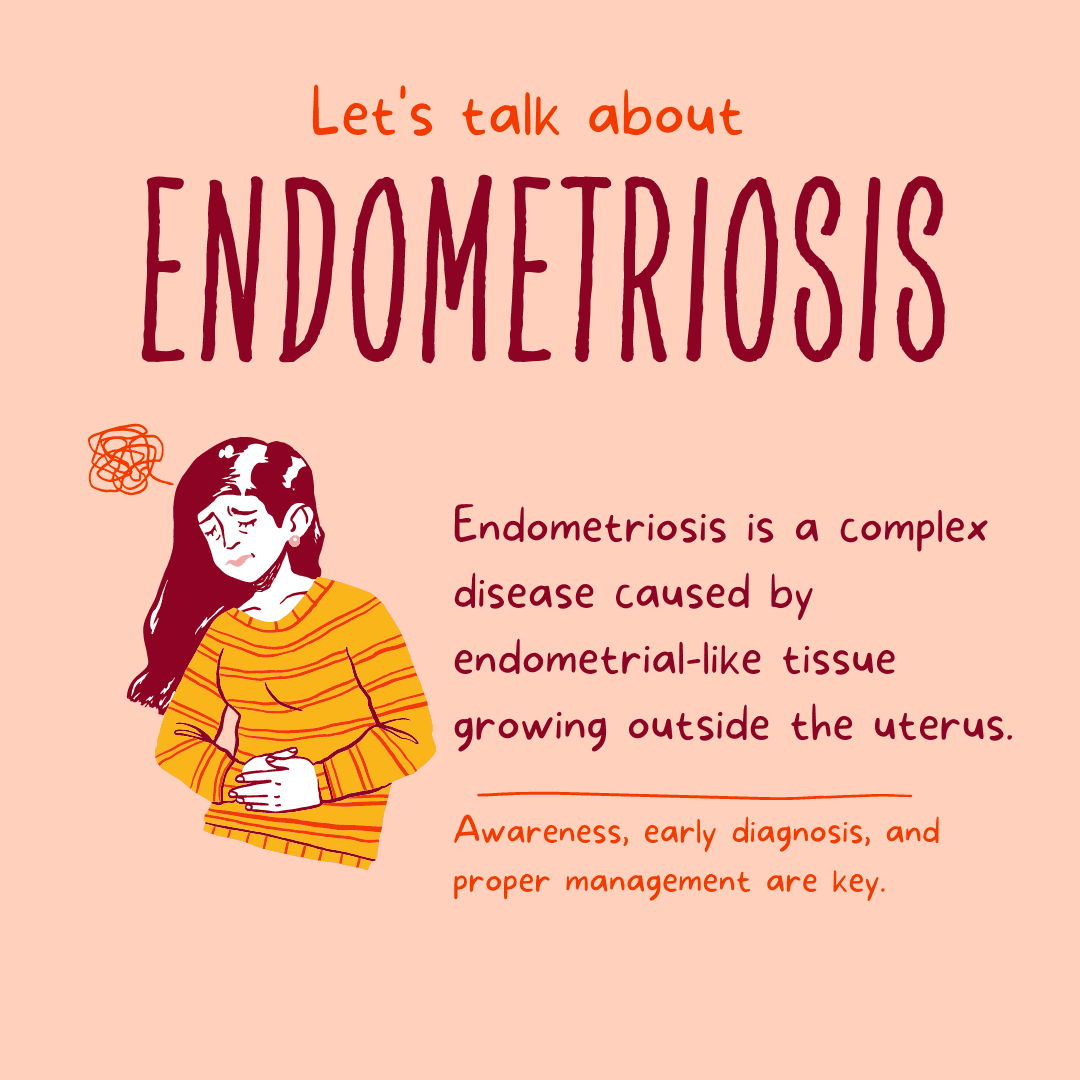
©Canva Creative Studio via Canva.com
What is it and what are the facts?
Endometriosis is a disease in which tissue similar to the lining of the uterus grows outside the uterus, such as the ovaries and fallopian tubes, in some cases the tissue can also be found on other organs in the body such as the lungs. It can cause severe pain in the pelvis and make it harder to get pregnant.
- Endometriosis affects roughly 10% of reproductive-age women and girls (190 million) globally.
- It is a chronic disease associated with severe, life-impacting pain during periods, sexual intercourse, bowel movements and/or urination, chronic pelvic pain, abdominal bloating, nausea, fatigue, and sometimes depression, anxiety, and infertility.
- There is currently no known cure for endometriosis and treatment is usually aimed at controlling symptoms.
- Access to early diagnosis and effective treatment of Endometriosis is important but is limited in many settings, including in low- and middle-income countries.
The Gender Health Gap and Endometriosis
On average, it takes women 8 years to get a diagnosis – mostly because the disease is often dismissed as a bad period or due to poor pain threshold.

©Canva Creative Studio via Canva.com
The ‘Gender Health Gap’ describes the institutionalised sexism within healthcare leading to poorer outcomes for women. For example, women today reportedly spend around one-quarter of their lives in poorer health, compared to men who spend one-fifth. In July 2022, the UK government released a strategy to close the ‘Gender Health Gap’, by increasing resources for female-specific health conditions, in an effort to reduce diagnosis time and disparity in outcomes between men and women. This includes extra provisions for diseases such as endometriosis.
Additionally, studies show Asian women are 50% more likely to suffer from endometriosis than White women, whereas Black women were half as likely to suffer from the disease than White women. However, it is also important to note that this data should be cautioned with the understanding that non-white women are also less likely to present to healthcare providers (HCPs).
Health Care, Clinical Trials and Endometriosis
Endometriosis costs the UK economy £8.2bn a year in treatment, loss of work and healthcare costs. Furthermore, addressing the issues of endometriosis is key to supporting the human rights of those suffering. So what can we do? Education is key, whether it be for healthcare professionals or across the board in the pharmaceutical industry. Historically, we know there is often limited investment into women’s health in general, diseases such as Endometriosis exemplify how damaging this is. An All-Party Parliamentary Group (APPG) report on endometriosis in 2020 discovered:
- There are no NHS care pathways
- their job, whilst 35% had a reduced income due to endometriosis.
- s for endometriosis outside the pelvic cavity, despite it affecting up to 10% of those with endometriosis.
- 46% found their GP(s) ‘unhelpful’ or ‘very unhelpful’.
- 58% would have liked fertility support and treatment but were not offered it, despite endometriosis doubling the risk of infertility.
- 38% were concerned about losing90% would have liked access to psychological support but were not offered this.
From a patient recruitment perspective, our recommendations include:
- Protocol allowances to consider the debilitating symptoms of endometriosis, such as home visits, and ensuring access to mental health support is available.
- Education to site staff and HCPs on the disease and listening to women’s pain in order to reduce time to diagnosis – we can do this through workshops or CEM coaching.
- Given that Asian women are over 50% more likely to be diagnosed with endometriosis is it important to note that discussions regarding reproductive health can be difficult or inappropriate in some cultures. The quickest solution to this is representation – women of all cultures and ethnicities should be included as early as possible in discussions of conditions that impact their health at a greater rate.
- In addition to impacting important conversations; representation also creates a safe space for cultural sensitivities to be discussed and cultivates an environment in which patients and other people can create shared experiences e.g. through the use of patient advocacy groups (PAGs).
- Sponsor-enforced diversity endpoints to ensure the patient population is representative of the community most affected.
Conclusion
There is evidently more research to be done in the area of endometriosis so we can cumulatively reduce diagnosis time, improve quality of life and find a potential cure. The first steps to do this are raising awareness and increasing education, here are some links to start both:
https://www.Endometriosis-uk.org/Endometriosis-facts-and-figures
https://www.hcf.com.au/health-agenda/women/Endometriosis/misconceptions
References
- “APPG release new report on endometriosis.” Endometriosis UK, https://www.endometriosis-uk.org/appg-release-new-report-endometriosis. Accessed 30 March 2023.
- Broster, Alice. “Why Is Endometriosis So Poorly Understood? The Gender Health Gap May Explain.” EndoFound, 2 June 2021, https://www.endofound.org/why-is-endometriosis-so-poorly-understood-the-gender-health-gap-may-explain. Accessed 30 March 2023.
- “The burden of endometriosis: costs and quality of life of women with endometriosis and treated in referral centres.” PubMed, 14 March 2012, https://pubmed.ncbi.nlm.nih.gov/22422778/. Accessed 30 March 2023.
- “Endometriosis.” World Health Organization (WHO), 24 March 2023, https://www.who.int/news-room/fact-sheets/detail/endometriosis. Accessed 30 March 2023.
- “Endometriosis Facts and Figures.” Endometriosis UK, https://www.endometriosis-uk.org/endometriosis-facts-and-figures. Accessed 30 March 2023.
- Liebert, Mary Ann. “How Women with Endometriosis Experience Health Care Encounters.” NCBI, https://www.ncbi.nlm.nih.gov/pmc/articles/PMC7785068/. Accessed 30 March 2023.
- “Revisiting the impact of race/ethnicity in endometriosis.” NCBI, 17 March 2022, https://www.ncbi.nlm.nih.gov/pmc/articles/PMC9066945/. Accessed 30 March 2023.
- Tate, Carolyn. “Facts and myths about endometriosis.” HCF, https://www.hcf.com.au/health-agenda/women/endometriosis/misconceptions. Accessed 30 March 2023.
- “Whitepaper: Closing the gender health gap.” Livi, 26 October 2022, https://www.livi.co.uk/news/whitepaper-closing-the-gender-health-gap/. Accessed 30 March 2023.